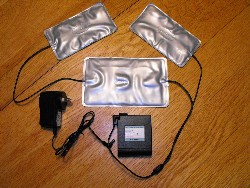 I spend a lot of time in a secret underground laboratory (basement workshop/office). It’s my version of a Man Cave. In place of a big screen TV, pool table, and bar, it has (along with every power tool known to modern man) an oscilloscope, a table saw, and a box of red wine sitting on top my computer tower.
I spend a lot of time in a secret underground laboratory (basement workshop/office). It’s my version of a Man Cave. In place of a big screen TV, pool table, and bar, it has (along with every power tool known to modern man) an oscilloscope, a table saw, and a box of red wine sitting on top my computer tower.
It’s also completely unfinished (exposed studs) and unheated, with no insulation in the walls whatsoever. The temperature at my desk is presently 52 degrees and thanks to the thermal mass of the concrete walls and floor, will remain at this approximate temperature for the four coldest winter months. It’s 39 degrees outside as I write. The cave analogy isn’t too far off.
Staying warm while sitting on one’s ass in front of a computer for hours on end in a 52 degree room can be challenging.
I’ve tried using a space heater under my desk but it sucks 1,200 watts of power just to make my shins sweat while I shiver from the knees up. There was also the potential for my pants to catch on fire. I’ve tried running the clothes dryer and venting it into the basement but this created a noticeable spike in our monthly electric bill. I installed some extra vents in our gas furnace ducting that I can open into the basement, but this created an equally obvious spike in our gas bill.
I finally solved the problem with some electrically heated clothing. This system uses (literally) a hundred times less energy than a space heater and keeps me warm and cozy from head to toe. By keeping my basement unheated I’ve reduced the natural gas consumption in our two-story home by roughly thirty percent.
The vest is the heart of the system. I don’t want to recommend a specific heated jacket because the one I chose may fail or blow up any day. I will say this much: the one I chose is working flawlessly to date. It has six pockets sewn inside with Velcro strips to keep them closed. It comes with three carbon fiber heating pads, a lithium ion battery pack, and a charger. You can place all three pads on the backside of the jacket or just one on back and two in front. The battery pack is integrated with a battery management circuit board, has five power settings and, ah, a diode flashlight. You get about five hours of heat on the highest setting, which is usually not needed, seven hours on the next setting, and up to fourteen hours on the lowest setting, all for a hundred bucks.
The manufacturer claims you will get 500 to 1,000 charges, depending. When my batteries have reached the end of their useful life I plan to use one of my Dewalt power tool batteries in a fanny pack using a rheostat and some simple circuitry to control power. While researching this I found other manufacturers of similar jackets. One of them claims to have a hibernation circuit that will protect your batteries from self-discharging too far over the summer months and being damaged. This problem can also be dealt with by periodically charging your pack over the summer.
Of course, the battery pack is made in China. I am not sure which battery chemistry it uses. I suspect it is lithium ion as opposed to lithium polymer, which means it could explode in my pocket and ruin my day. I am also not sure if the battery management system will automatically shut the pack off before it discharges to the point that it will be damaged. I play it safe and make sure I don’t let it discharge too far.
The jacket is usually all I need, but because my feet can get cold after enough time sitting on a 50 degree slab of concrete, I also have a heat pad on the floor that I can slip my feet under. I keep another one handy that I can put on my lap as well. These can be purchased at any pharmacy for ten to twenty dollars. I keep them plugged into a switched power strip (with indicator light) on my desk.
I bought my jacket (marketed by a company located in an obscure town called Tumwater, hint, hint) at a motorcycle accessory shop.
Ideas like these don’t really have much value in the big scheme of things unless they catch on and are used by tens of millions. What would motivate tens of millions of Americans to stop heating their Man Caves and switch to heated clothing?
 I spend a lot of time in a secret underground laboratory (basement workshop/office). It's my version of a
I spend a lot of time in a secret underground laboratory (basement workshop/office). It's my version of a 
